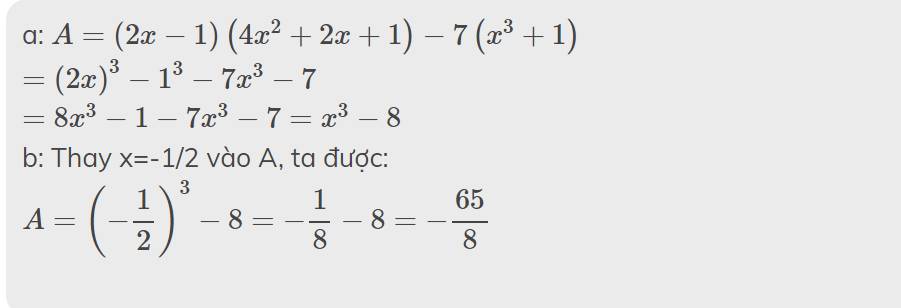Cho A=x²+2x+1÷x²-1
Tìm các giá trị nguyên của x để A có giá trị nguyên.
Hãy nhập câu hỏi của bạn vào đây, nếu là tài khoản VIP, bạn sẽ được ưu tiên trả lời.

A = \(\dfrac{2x-1}{x+2}\)
a, A là phân số ⇔ \(x\) + 2 # 0 ⇒ \(x\) # -2
b, Để A là một số nguyên thì 2\(x-1\) ⋮ \(x\) + 2
⇒ 2\(x\) + 4 - 5 ⋮ \(x\) + 2
⇒ 2(\(x\) + 2) - 5 ⋮ \(x\) + 2
⇒ 5 ⋮ \(x\) + 2
⇒ \(x\) + 2 \(\in\) { -5; -1; 1; 5}
⇒ \(x\) \(\in\) { -7; -3; -1; 3}
c, A = \(\dfrac{2x-1}{x+2}\)
A = 2 - \(\dfrac{5}{x+2}\)
Với \(x\) \(\in\) Z và \(x\) < -3 ta có
\(x\) + 2 < - 3 + 2 = -1
⇒ \(\dfrac{5}{x+2}\) > \(\dfrac{5}{-1}\) = -5 ⇒ - \(\dfrac{5}{x+2}\)< 5
⇒ 2 - \(\dfrac{5}{x+2}\) < 2 + 5 = 7 ⇒ A < 7 (1)
Với \(x\) > -3; \(x\) # - 2; \(x\in\) Z ⇒ \(x\) ≥ -1 ⇒ \(x\) + 2 ≥ -1 + 2 = 1
\(\dfrac{5}{x+2}\) > 0 ⇒ - \(\dfrac{5}{x+2}\) < 0 ⇒ 2 - \(\dfrac{5}{x+2}\) < 2 (2)
Với \(x=-3\) ⇒ A = 2 - \(\dfrac{5}{-3+2}\) = 7 (3)
Kết hợp (1); (2) và(3) ta có A(max) = 7 ⇔ \(x\) = -3

a: \(A=\left(2x-1\right)\left(4x^2+2x+1\right)-7\left(x^3+1\right)\)
\(=\left(2x\right)^3-1^3-7x^3-7\)
\(=8x^3-1-7x^3-7=x^3-8\)
b: Thay x=-1/2 vào A, ta được:
\(A=\left(-\dfrac{1}{2}\right)^3-8=-\dfrac{1}{8}-8=-\dfrac{65}{8}\)


c: \(A=x^3-8=\left(x-2\right)\left(x^2+2x+4\right)\)
Để A là số nguyên tố thì x-2=1
=>x=3

a) Để \(f\left(x\right)=3\)
\(\Leftrightarrow\frac{2x+1}{2x+3}=3\)
\(\Leftrightarrow3.\left(2x+3\right)=2x+1\)
\(\Leftrightarrow6x+9=2x+1\)
\(\Leftrightarrow6x-2x=1-9\)
\(\Leftrightarrow4x=-8\)
\(\Leftrightarrow x=-2\)
Để f(x) nguyên
\(\Leftrightarrow2x+1⋮2x+3\)
\(\Leftrightarrow2x+3-2⋮2x+3\)
mà \(2x+3⋮2x+3\)
\(\Rightarrow2⋮2x+3\)
\(\Rightarrow2x+3\inƯ\left(2\right)=\left\{\pm1;\pm2\right\}\)
Lập bảng rồi tìm x nguyên nhé

a) Ta có: \(A=\left(1+\dfrac{x^2}{x^2+1}\right):\left(\dfrac{1}{x-1}-\dfrac{2x}{x^3+x-x^2-1}\right)\)
\(=\dfrac{2x^2+1}{x^2+1}:\dfrac{x^2+1-2x}{\left(x-1\right)\left(x^2+1\right)}\)
\(=\dfrac{2x^2+1}{x^2+1}\cdot\dfrac{\left(x-1\right)\left(x^2+1\right)}{\left(x-1\right)^2}\)
\(=\dfrac{2x^2+1}{x-1}\)
b) Thay \(x=-\dfrac{1}{2}\) vào A, ta được:
\(A=\left(2\cdot\dfrac{1}{4}+1\right):\left(\dfrac{-1}{2}-1\right)\)
\(=\dfrac{3}{2}:\dfrac{-3}{2}=-1\)
c) Để A<1 thì A-1<0
\(\Leftrightarrow\dfrac{2x^2+1}{x-1}-1< 0\)
\(\Leftrightarrow\dfrac{2x^2+1-x+1}{x-1}< 0\)
\(\Leftrightarrow\dfrac{2x^2-x+2}{x-1}< 0\)
\(\Leftrightarrow x-1< 0\)
hay x<1
Ta có \(A=\frac{x^2+2x+1}{x^2-1}\left(x\ne\pm1\right)\)
\(=\frac{\left(x+1\right)^2}{\left(x-1\right)\left(x+1\right)}=\frac{x+1}{x-1}=\frac{x-1+2}{x-1}=1+\frac{2}{x-1}\)
Để A nguyên => \(\frac{2}{x-1}\)nguyên => 2 chia hết cho x-1
x nguyên => x-1 nguyên => x-1 \(\in\)Ư(2)={-2;-1;1;2}
ta có bảng